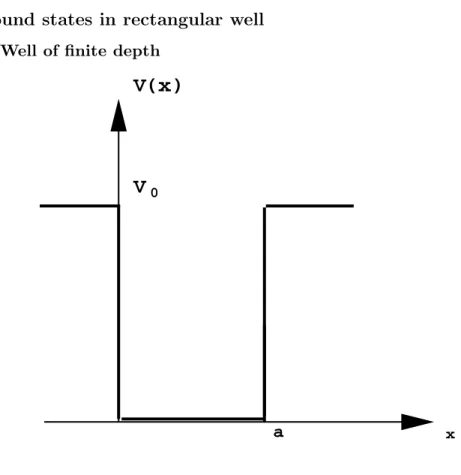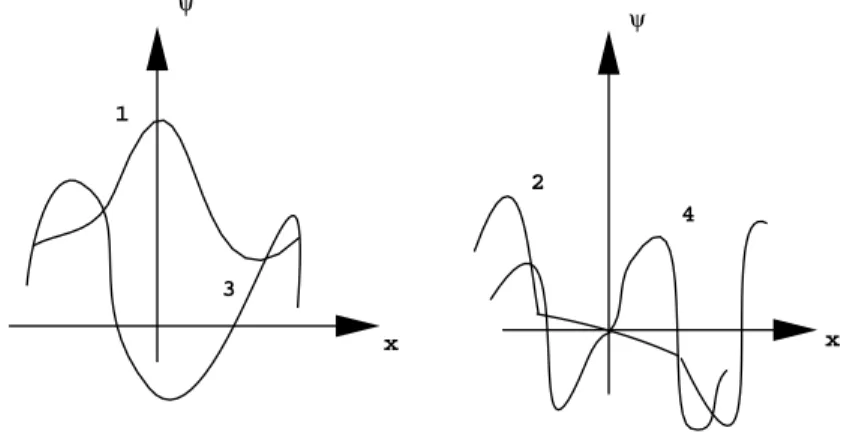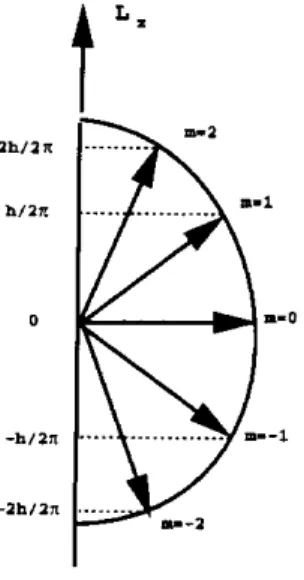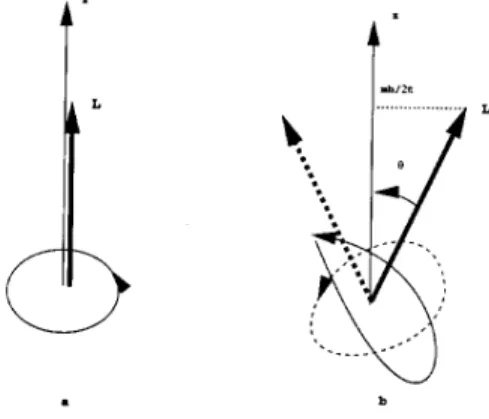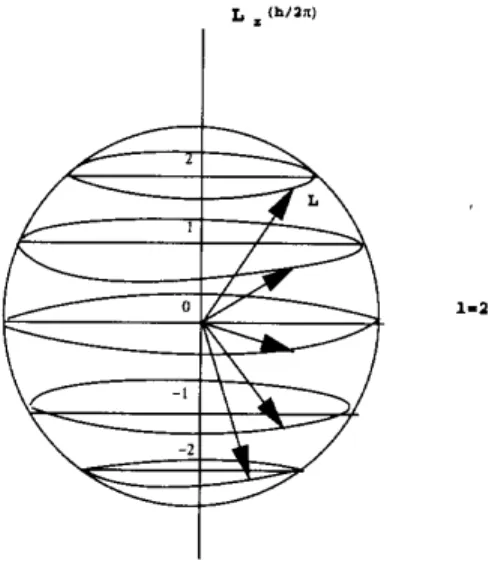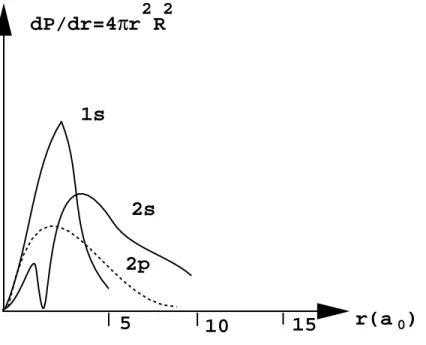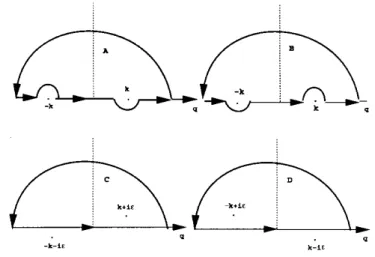arXiv:physics/0004072v2 [physics.ed-ph] 29 Apr 2000
Los Alamos Electronic ArXives http://xxx.lanl.gov/physics/0004072
ELEMENTARY QUANTUM MECHANICS
HARET C. ROSU e-mail: rosu@ifug3.ugto.mx
fax: 0052-47187611 phone: 0052-47183089
h/2 π
Copyright c2000 by the author. All commercial rights are reserved.
April 2000
Abstract
This is the first graduate course on elementary quantum mechanics in Inter- net written for the benefit of undergraduate and graduate students. It is a translation (with corrections) of the Romanian version of the course, which I did at the suggestion of several students from different countries. The top- ics included refer to the postulates of quantum mechanics, one-dimensional barriers and wells, angular momentum and spin, WKB method, harmonic oscillator, hydrogen atom, quantum scattering, and partial waves.
CONTENTS
0. Forward ... 4
1. Quantum postulates ... 5
2. One-dimensional rectangular barriers and wells ... 23
3. Angular momentum and spin ... 45
4. The WKB method ... 75
5. The harmonic oscillator ... 89
6. The hydrogen atom ... 111
7. Quantum scattering ... 133
8. Partial waves ... 147
There are about 25 illustrative problems.
Spacetime nonrelativistic atomic units aH = ¯h2/mee2 = 0.529·10−8cm tH = ¯h3/mee4 = 0.242·10−16sec Planck relativistic units of space and time
lP = ¯h/mPc= 1.616·10−33cm tP = ¯h/mPc2 = 5.390·10−44sec
0. FORWARD
The energy quanta occured in 1900 in the work of Max Planck (Nobel prize, 1918) on the black body electromagnetic radiation. Planck’s “quanta of light” have been used by Einstein (Nobel prize, 1921) to explain the pho- toelectric effect, but the first “quantization” of a quantity having units of action (the angular momentum) belongs to Niels Bohr (Nobel Prize, 1922).
This opened the road to the universalization of quanta, since the action is the basic functional to describe any type of motion. However, only in the 1920’s the formalism of quantum mechanics has been developed in a system- atic manner. The remarkable works of that decade contributed in a decisive way to the rising of quantum mechanics at the level of fundamental theory of the universe, with successful technological applications. Moreover, it is quite probable that many of the cosmological misteries may be disentan- gled by means of various quantization procedures of the gravitational field, advancing our understanding of the origins of the universe. On the other hand, in recent years, there is a strong surge of activity in the information aspect of quantum mechanics. This aspect, which was generally ignored in the past, aims at a very attractive “quantum computer” technology.
At the philosophical level, the famous paradoxes of quantum mechanics, which are perfect examples of the difficulties of ‘quantum’ thinking, are actively pursued ever since they have been first posed. Perhaps the most famous of them is the EPR paradox (Einstein, Podolsky, Rosen, 1935) on the existence ofelements of physical reality, or in EPR words: “If, without in any way disturbing a system, we can predict with certainty (i.e., with probability equal to unity) the value of a physical quantity, then there exists an element of physical reality corresponding to this physical quantity.” Another famous paradox is that of Schr¨odinger’s cat which is related to the fundamental quantum property of entanglement and the way we understand and detect it. What one should emphasize is that all these delicate points are the sourse of many interesting and innovative experiments (such as the so-called
“teleportation” of quantum states) pushing up the technology.
Here, I present eight elementary topics in nonrelativistic quantum me- chanics from a course in Spanish (“castellano”) on quantum mechanics that I taught in the Instituto de F´ısica, Universidad de Guanajuato (IFUG), Le´on, Mexico, during the semesters of 1998.
Haret C. Rosu
1. THE QUANTUM POSTULATES
The following six postulates can be considered as the basis for theory and experiment in quantum mechanics in its most used form, which is known as the Copenhagen interpretation.
P1.- To any physical quantity L, which is well defined at the classical level, one can associate a hermitic operator ˆL.
P2.- To any stationary physical state in which a quantum system can be found one can associate a (normalized) wavefunction. ψ (kψk2L2= 1).
P3.- In (appropriate) experiments, the physical quantity L can take only the eigenvalues of ˆL. Therefore the eigenvalues should be real, a condition which is fulfilled only by hermitic operators.
P4.- What one measures is always the mean valueLof the physical quantity (i.e., operator) ˆL in a state ψn, which, theoretically speaking, is the corresponding diagonal matrix element
hψn|Lˆ|ψni=L.
P5.- The matrix elements of the operators corresponding to the cartesian coordinate and momentum,xbi andcpk, when calculated with the wave- functionsf andgsatisfy the Hamilton equations of motion of classical mechanics in the form:
d
dthf |pbi |gi=−hf | ∂Hb
∂xbi |gi d
dthf |xbi|gi=hf | ∂Hb
∂pbi |gi ,
where Hb is the hamiltonian operator, whereas the derivatives with respect to operators are defined as at point 3 of this chapter.
P6.- The operators pbi and xck have the following commutators:
[pbi,xck] =−i¯hδik, [pbi,cpk] = 0, [xbi,xck] = 0
¯
h=h/2π = 1.0546×10−27 erg.sec.
1.- The correspondence between classical and quantum quantities
This can be done by substitutingxi,pk withxbi cpk. The function L is supposed to be analytic (i.e., it can be developed in Taylor series). If the L function does not contain mixed productsxkpk, the operator ˆL is directly hermitic.
Exemple:
T = (P3i p2i)/2m −→Tb= (P3i pb2)/2m.
If L contains mixed productsxipi and higher powers of them, ˆLis not hermitic, and in this case L is substituted by ˆΛ, the hermitic part of Lˆ (ˆΛ is an autoadjunct operator).
Exemple:
w(xi, pi) =Pipixi −→ wb = 1/2P3i(pbixbi+xbipbi).
In addition, one can see that we have no time operator. In quan- tum mechanics, time is only a parameter that can be introduced in many ways. This is so because time does not depend on the canonical variables, merely the latter depend on time.
2.- Probability in the discrete part of the spectrum Ifψn is an eigenfunction of the operator ˆL, then:
L=< n|Lˆ|n >=< n|λn|n >=λn< n|n >=δnnλn=λn. Moreover, one can prove thatLk= (λn)k.
If the functionφis not an eigenfunction of ˆL, one can make use of the expansion in the complete system of eigenfunctions of ˆL to get:
Lψˆ n=λnψn, φ=Pnanψn and combining these two relationships one gets:
Lφˆ =Pnλnanψn.
In this way, one is able to calculate the matrix elements of the operator L:ˆ
hφ|Lˆ |φi=Pn,ma∗manλnhm|ni=Pm|am|2 λm,
telling us that the result of the experiment is λm with a probability
|am |2.
If the spectrum is discrete, according to P4 this means that |am |2, that is the coefficients of the expansion in a complete set of eigenfunc- tions, determine the probabilitities to observe the eigenvalueλn. If the spectrum is continuous, using the following definition
φ(τ) =R a(λ)ψ(τ, λ)dλ,
one can calculate the matrix elements in the continuous part of the spectrum
hφ|Lˆ |φi
=R dτRa∗(λ)ψ∗(τ, λ)dλR µa(µ)ψ(τ, µ)dµ
=R R a∗a(µ)µR ψ∗(τ, λ)ψ(tau, µ)dλdµdτ
=R R a∗(λ)a(µ)µδ(λ−µ)dλdµ
=R a∗(λ)a(λ)λdλ
=R |a(λ)|2λdλ.
In the continuous case,|a(λ)|2 should be understood as the probabil- ity density for observing the eigenvalueλbelonging to the continuous spectrum. Moreover, the following holds
L=hφ|Lˆ|φi.
One usually says that hµ | Φi is the representation of | Φi in the representation µ, where |µi is an eigenvector of ˆM.
3.- Definition of the derivate with respect to an operator
∂F( ˆL)
∂Lˆ = limǫ→∞F( ˆL+ǫI)ˆ−F( ˆL)
ǫ .
4.- The operators of cartesian momenta
Which is the explicit form of cp1, cp2 and cp3, if the arguments of the wavefunctions are the cartesian coordinatesxi ?
Let us consider the following commutator:
[pbi,xbi2] =pbixbi2−xbi2pbi
=pbixbixbi−xbipbixbi+xbipbixbi−xbixbipbi
= (pbixbi−xbipbi)xbi+xbi(pbixbi−xbipbi)
= [pbi,xbi]xbi+xbi[pbi,xbi]
=−i¯hxbi−i¯hxbi =−2i¯hxbi. In general, the following holds:
b
pixbin−xbinpbi=−ni¯hxbin−1. Then, for all analytic functions we have:
b
piψ(x)−ψ(x)pbi =−i¯h∂x∂ψ
i.
Now, letpbiφ=f(x1, x2, x3) be the manner in whichpbiacts onφ(x1, x2, x3) = 1. Then:
b
piψ=−i¯h∂x∂ψ1 +f1ψ and similar relationships hold for x2 andx3. From the commutator [pbi,pck] = 0 it is easy to get ∇ ×f~ = 0 and thereforefi =∇iF.
The most general form of pbi is pbi =−i¯h∂x∂
i +∂x∂F
i, where F is an ar- bitrary function. The function F can be eliminated by the unitary transformaton Ub†= exp(¯hiF).
b
pi=Ub†(−i¯h∂x∂
i +∂x∂F
i)Ub
= exph¯iF(−i¯h∂x∂
i +∂x∂F
i) exp−i¯hF
=−i¯h∂x∂
i
leading to pbi =−i¯h∂x∂
i −→ pb=−i¯h∇. 5.- Calculation of the normalization constant
Any wavefunction ψ(x) ∈ L2 of variablex can be written in the form:
ψ(x) =R δ(x−ξ)ψ(ξ)dξ
that can be considered as the expansion of ψ in eigenfunction of the operator position (cartesian coordinate) ˆxδ(x−ξ) =ξ(x−ξ). Thus,
|ψ(x)|2 is the probability density of the coordinate in the state ψ(x).
From here one gets the interpretation of the norm
kψ(x)k2=R |ψ(x)|2dx= 1.
Intuitively, this relationship tells us that the system described byψ(x) should be encountered at a certain point on the real axis, although we can know only approximately the location.
The eigenfunctions of the momentum operator are:
−i¯h∂x∂ψ
i =piψ, and by integrating one getsψ(xi) =Aexph¯ipixi. xandp have continuous spectra and therefore the normalization is performed by means of the Dirac delta function.
Which is the explicit way of getting the normalization constant ? This is a matter of the following Fourier transforms:
f(k) =R g(x) exp−ikxdx, g(x) = 2π1 R f(k) expikxdk.
It can also be obtained with the following procedure. Consider the unnormalized wavefunction of the free particle
φp(x) =Aexpipx¯h and the formula
δ(x−x′) = 2π1 R−∞∞ expik(x−x′)dx .
One can see that
R∞
−∞φ∗
p′(x)φp(x)dx
=R−∞∞ A∗exp−ip
′x
¯
h Aexpipx¯h dx
=R−∞∞ |A|2expix(p−p
′)
¯
h dx
=|A|2¯hR−∞∞ expix(p−p
′)
¯ h dx¯h
= 2π¯h|A|2 δ(p−p′) and therefore the normalization constant is:
A= √1 2π¯h.
Moreover, the eigenfunctions of the momentum form a complete sys- tem (in the sense of the continuous case) for all functions of the L2 class.
ψ(x) = √1 2π¯h
R a(p) expipxh¯ dp
a(p) = √1 2π¯h
R ψ(x) exp−ipxh¯ dx.
These formulae provide the connection between the x and p represen- tations.
6.- The momentum (p) representation
The explicit form of the operators ˆpi and ˆxk can be obtained either from the commutation relationships or through the usage of the kernels
x(p, β) =U†xU= 2π¯1hR exp−ipx¯h xexpiβx¯h dx
= 2π¯1hR exp−ipxh¯ (−i¯h∂β∂ expiβx¯h ).
The integral is of the form: M(λ, λ′) = R U†(λ, x)M U(λc ′, x)dx, and using ˆxf =R x(x, ξ)f(ξ)dξ, the action of ˆx on a(p) ∈ L2 is:
ˆ
xa(p) =R x(p, β)a(β)dβ
=R(2π¯1hR exp−ipx¯h (−i¯h∂β∂ expiβxh¯ )dx)a(β)dβ
= −2πiR Rexp−ipx¯h ∂β∂ expiβx¯h a(β)dxdβ
= −2πi¯hR Rexp−ipx¯h ∂β∂ expiβx¯h a(β)dx¯hdβ
= −2πi¯hR Rexpix(β−p)h¯ ∂β∂ a(β)dx¯hdβ
=−i¯hR ∂a(p)∂β δ(β −p)dβ =−i¯h∂a(p)∂p ,
where δ(β−p) = 2π1 R expix(β−p)¯h dx¯h.
The momentum operator in the p representation is defined by the ker- nel:
p(p, β) =Ub†pUb
= 2π¯1hR exp−ipxh¯ (−i¯h∂x∂ ) expiβx¯h dx
= 2π¯1hRexp−ipx¯h βexpiβx¯h dx=βλ(p−β)
leading to ˆpa(p) =pa(p).
It is worth noting that ˆx and ˆp, although hermitic operators for all f(x)∈ L2, are not hermitic for their own eigenfunctions.
If ˆpa(p) =poa(p) and ˆx= ˆx† pˆ= ˆp†, then
< a|pˆˆx|a >−< a|xˆpˆ|a >=−i¯h < a|a >
po[< a|xˆ|a >−< a|xˆ|a >] =−i¯h < a|a >
po[< a|xˆ|a >−< a|xˆ|a >] = 0
The left hand side is zero, whereas the right hand side is indefinite, which is a contradiction.
7.- Schr¨odinger and Heisenberg representations
The equations of motion given by P5 have different interpretations because in the expression dtdhf |Lˆ |fi one can consider the temporal dependence as belonging either to the wavefunctions or operators, or both to wavefunctions and operators. We shall consider herein only the first two cases.
• For an operator depending on timeOb =O(t) we have:d ˆ
pi =−∂∂Hxbˆi, xˆi = ∂∂Hpbˆ
i
[ˆp, f] = ˆpf −fpˆ=−i¯h∂∂fxˆ
i
[ˆx, f] = ˆxf −fxˆ=−i¯h∂∂fpˆ
i
and the Heisenberg equations of motion are easily obtained:
ˆ
pi= −¯hi[ˆp,H],b xˆi= −¯hi[ˆx,H].b
• If the wavefunctions are time dependent one can still use ˆpi =
−i
¯
h[ ˆpi,H], because being a consequence of the commutation rela-b tions it does not depend on representation
d
dt < f |pˆi |g >= −¯hi < f |[ˆp,H]b |g >.
If now ˆpi andHb do not depend on time, taking into account the hermiticity, one gets:
(∂f∂t,pˆig) + ( ˆpif,∂g∂t)
= −¯hi(f,pˆiHg) +ˆ ¯hi(f,Hˆpˆig)
= −¯hi(ˆpf,Hg) +ˆ ¯hi( ˆHf,pˆig) (∂f∂t +¯hiHf,ˆ pˆig) + ( ˆpif,∂g∂t − ¯hiHg) = 0ˆ
The latter relationship holds for any pair of functions f(x) and g(x) at the initial moment if each of them satisfies the equation
i¯h∂ψ∂t =Hψ.
This is the Schr¨odinger equation. It describes the system by means of time-independent operators and makes up the so-called Schr¨odinger representation.
In both representations the temporal evolution of the system is char- acterized by the operator H, which can be obtained from Hamilton’sb function of classical mechanics.
Exemple: Hb for a particle in a potential U(x1, x2, x3) we have:
Hb = 2mpˆ2 +U(x1, x2, x3), which in the x representation is:
Hb =−2m¯h2∇2x+U(x1, x2, x3).
8.- The connection between the S and H representations
P5 is correct in both Schr¨odinger’s representation and Heisenberg’s.
This is why, the mean value of any observable coincides in the two
representations. Thus, there is a unitary transformation that can be used for passing from one to the other. Such a transformation is of the form ˆs† = exp−i¯hHtˆ . In order to pass to the Schr¨odinger repre- sentation one should use the Heisenberg transform ψ = ˆs†f with f and ˆL, whereas to pass to Heisenberg’s representation the Schr¨odinger transform ˆΛ = ˆs†Lˆˆs with ψ and ˆΛ is of usage. One can obtain the Schr¨odinger equation as follows: since in the transformation ψ= ˆs†f the function f does not depend on time, we shall derivate the trans- formation with respect to time to get:
∂ψ
∂t = ∂s∂t†f = ∂t∂(exp−i¯hHtb )f = −¯hiHb exp−ih¯Htb f = −¯hiHbsˆ†f = −¯hiHψ.b Therefore:
i¯h∂ψ∂t =Hψ.b
Next we get the Heisenberg equations: putting the Schr¨odinger trans- form in the form ˆsΛ ˆˆs†= ˆLand performing the derivatives with respect to time one gets Heisenberg’s equation
∂Lˆ
∂t =∂ˆ∂tsΛ ˆˆs†+ ˆsΛˆ∂∂tsˆ† = ¯hiHbexpiHtb¯h Λ ˆˆs†−¯hisˆλˆexp−i¯hHtˆ Hb
= ¯hi(HˆbsΛ ˆˆs†−ˆsΛ ˆˆs†H) =b ¯hi(HbLˆ−LˆH) =b ¯hi[H,b L].ˆ Thus, we have:
∂Lˆ
∂t = ¯hi[H,b L].ˆ
Moreover, Heisenberg’s equation can be written in the form:
∂Lˆ
∂t = ¯his[ˆH,b Λ] ˆˆ s†.
Lˆ is known as an integral of motion, which, if dtd < ψ |Lˆ |ψ >= 0, is characterized by the following commutators:
[H,b L] = 0,ˆ [H,b Λ] = 0.ˆ 9.- Stationary states
The states of a quantum system described by the eigenfunctions ofHb are called stationary states and the corresponding set of eigenvalues is known as the energy spectrum of the system. In such cases, the Schroedinger equation is:
i¯h∂ψ∂tn =Enψn=Hψb n.
The solutions are of the form: ψn(x, t) = exp−iEnth¯ φn(x).
• The probability is the following:
δ(x) =|ψn(x, t)|2=|exp−iEnt¯h φn(x)|2
= expiEnt¯h exp−iEnt¯h |φn(x)|2=|φn(x)|2. Thus, the probability is constant in time.
• In the stationary states, the mean value of any commutator of the form [H,b A] is zero, where ˆˆ A is an arbitrary operator:
< n|HbAˆ−AˆHb |n >=< n|HbAˆ|n >−< n|AˆHb |n >
=< n|EnAˆ|n >−< n|AEˆ n|n >
=En< n|Aˆ|n >−En< n|Aˆ|n >= 0.
• The virial theorem in quantum mechanics - ifHb is a hamiltonian operator of a particle in the fieldU(r), using
Aˆ= 1/2P3i=1( ˆpixˆi−xˆipˆi) one gets:
< ψ|[ ˆA,H]b |ψ >= 0 =< ψ|AˆHb −HbAˆ|ψ >
=P3i=1 < ψ|pˆixˆiHb −Hbpˆixˆi |ψ >
=P3i=1< ψ|[H,b xˆi] ˆpi+ ˆxi[H,b pˆi]|ψ >.
Using several times the commutators and ˆpi = −i¯h∇i, ˆH = Tb+U(r), one can get:
< ψ |[ ˆA,H]b |ψ >= 0
=−i¯h(2< ψ|Tb |ψ >−< ψ|~r· ∇U(r)|ψ >).
This is the virial theorem. If the potential is U(r) =Uorn, then a form of the virial theorem similar to that in classical mechanics can be obtained with the only difference that it refers to mean values
T = n2U.
• For a HamiltonianHb =−2m¯h2∇2+U(r) and [~r, H] = −mi¯h~p, calcu- lating the matrix elements one finds:
(Ek−En)< n|~r|k >= i¯mh < n|pˆ|k >.
10.- The nonrelativistic probability current density The following integral:
R |ψn(x)|2 dx= 1,
is the normalization of an eigenfunction of the discrete spectrum in the coordinate representation. It appears as a condition on the micro- scopic motion in a finite region of space.
For the wavefunctions of the continuous spectrum ψλ(x) one cannot give a direct probabilistic interpretation.
Let us consider a given wavefunctionφ∈ L2, that we write as a linear combination of eigenfunctions of the continuum:
φ=R a(λ)ψλ(x)dx.
One says thatφ corresponds to an infinite motion.
In many cases, the functiona(λ) is not zero only in a small neighbor- hood of a point λ=λo. In such a case, φis known as a wavepacket.
We shall calculate now the rate of change of the probability of finding the system in the volume Ω.
P =RΩ|ψ(x, t)|2dx=RΩψ∗(x, t)ψ(x, t)dx.
Derivating the integral with respect to time leads to
dP
dt =RΩ(ψ∂ψ∂t∗ +ψ∗∂ψ∂t)dx.
Using now the Schr¨odinger equation in the integral of the right hand side, one gets:
dP
dt = ¯hi RΩ(ψHψˆ ∗−ψ∗Hψ)dx.ˆ
Using the identity f∇2g−g∇2f =div[(f)grad(g)−(g)grad(f)] and also the Schr¨odinger equation in the form:
Hψˆ = 2m¯h2∇2ψ and subtituting in the integral, one gets:
dP
dt = ¯hi RΩ[ψ(−2m¯h2∇ψ∗)−ψ∗(−2m¯h2∇ψ)]dx
=−RΩ2mi¯h(ψ∇ψ∗−ψ∗∇ψ)dx
=−RΩdiv2mi¯h(ψ∇ψ∗−ψ∗∇ψ)dx.
By means of the divergence theorem, the volume integral can be trans- formed in a surface one leading to:
dP
dt =−H 2mi¯h(ψ∇ψ∗−ψ∗∇ψ)dx.
The quantity J(ψ) =~ 2mi¯h(ψ∇ψ∗−ψ∗∇ψ) is known as the probability density current, for which one can easily get the following continuity equation
dρ
dt +div(J~) = 0.
• Ifψ(x) =AR(x), whereR(x) is a real function, then: J(ψ) = 0.~
• For momentum eigenfunctionsψ(x) = (2π¯h)13/2expi~p~¯hx, one gets:
J(ψ) = 2mi¯h((2π¯h)13/2expi~p~¯hx(¯h(2π¯i~h)p3/2exp−i~¯hp~x)
−((2π¯h)13/2exp−i~h¯p~x ¯h(2π¯i~h)p3/2expi¯h~¯hp~x))
= 2mi¯h(−¯h(2π¯2i~ph)3) = m(2π¯~ph)3,
which shows that the probability density current does not depend on the coordinate.
11.- Operator of spatial transport
IfHb is invariant at translations of arbitrary vector~a, H(~rb +~a) =H ~b(r) ,
then there is an operator Tb(~a) which is unitary Tb†(~a)H(~r)b Tb(~a) = H(~rb +~a).
Commutativity of translations
Tb(~a)Tb(~b) =Tb(~b)Tb(~a) =Tb(~a+~b), implies that Tb is of the formTb= expiˆka, where ˆk= ¯hpˆ. In the infinitesimal case:
Tb(δ~a)HbT(δ~a)b ≈( ˆI+iˆkδ~a)H( ˆb I−ikδ~a),ˆ
H(~r) +b i[ ˆK,H]δ~ab =H(~r) + (b ∇H)δ~a.b
Moreover, [ˆp,H] = 0, where ˆb p is an integral of the motion. The sistem of wavefunctions of the formψ(~p, ~r) = (2π¯h)13/2expi~p~h¯r and the unitary transformation leads to expi~p~¯ha ψ(~r) =ψ(~r+~a). The operator of spatial transport Tb† = exp−i~¯hp~a is the analog of ˆs† = exp−i¯hHtˆ , which is the operator of time ‘transport’ (shift).
12.- Exemple: The ‘crystal’ (lattice) Hamiltonian
If Hb is invariant for a discrete translation (for exemple, in a crystal lattice) H(~rb +~a) = H(~r), whereb ~a = Pia~ini, ni ∈ N and ai are baricentric vectors, then:
H(~r)ψ(~r) =b Eψ(~r),
H(~rb +~a)ψ(~r+~a) =Eψ(~r+~a) = ˆH(~r)ψ(~r+~a).
Consequently,ψ(~r) andψ(~r+~a) are wavefunctions for the same eigen- value ofH. The relationship betweenb ψ(~r) andψ(~r+~a) can be saught for in the formψ(~r+~a) = ˆc(~a)ψ(~r), where ˆc(~a) is a gxg matrix (g is the order of degeneration of level E). Two column matrices, ˆc(~a) and ˆ
c(~b) commute and therefore they are diagonalizable simultaneously.
Moreover, for the diagonal elements, cii(~a)cii(~b) = cii(~a+~b) holds for i=1,2,....,g, having solutions of the type cii(a) = expikia. Thus, ψk(~r) =Uk(~r) expi~k~a, where~k is a real arbitrary vector and the func- tionUk(~r) is periodic of period~a,Uk(~r+~a) =Uk(~r).
The assertion that the eigenfunctions of a periodic ˆH of the lattice type ˆH(~r+~a) = ˆH(~r) can be written ψk(~r) = Uk(~r) expi~k~a, where Uk(~r+~a) = Uk(~r) is known as Bloch’s theorem. In the continuous case,Ukshould be constant, because the constant is the only function periodic for any~a. The vector ~p = ¯h~k is called quasimomentum (by analogy with the continuous case). The vector ~k is not determined univoquely, because one can add any vector ~g for which ga = 2πn, wheren∈ N.
The vector~gcan be written~g=P3i=1b~imi, wheremi are integers and bi are given by
b~i = 2πa~aˆj×a~k
i(a~j×a~k),
fori6=j6=k. b~i are the baricentric vectors of the lattice.
Recommended references
1. E. Farhi, J. Goldstone, S. Gutmann, “How probability arises in quantum mechanics”, Annals of Physics192, 368-382 (1989)
2. N.K. Tyagi in Am. J. Phys. 31, 624 (1963) gives a very short proof of the Heisenberg uncertainty principle, which asserts that the simultaneous mea- surement of two noncommuting hermitic operators results in an uncertainty given by the value of their commutator.
3. H.N. N´u˜nez-Y´epez et al., “Simple quantum systems in the momentum representation”, physics/0001030 (Europ. J. Phys., 2000).
4. J.C. Garrison, “Quantum mechanics of periodic systems”, Am. J. Phys.
67, 196 (1999).
5. F. Gieres, “Dirac’s formalism and mathematical surprises in quantum mechanics”, quant-ph/9907069 (in English); quant-ph/9907070 (in French).
1N. Notes
1. For “the creation of quantum mechanics...”, Werner Heisenberg has been awarded the Nobel prize in 1932 (delivered in 1933). The paper “Z¨ur Quan- tenmechanik. II”, [“On quantum mechanics.II”, Zf. f. Physik 35, 557- 615 (1926) (received by the Editor on 16 November 1925) by M. Born, W.
Heisenberg and P. Jordan, is known as the “work of the three people”, be- ing considered as the work that really opened the vast horizons of quantum mechanics.
2. For “the statistical interpretation of the wavefunction” Max Born was awarded the Nobel prize in 1954.
1P. Problems
Problema 1.1: Let us consider two operators, A and B, which commutes by hypothesis. In this case, one can derive the following relationship:
eAeB=e(A+B)e(1/2[A,B]). Solution
Defining an operator F(t), as a function of real variable t, of the form:
F(t) =e(At)e(Bt),
then: dFdt =AeAteBt+eAtBeBt= (A+eAtBe−At)F(t).
Applying now the formula [A, F(B)] = [A, B]F′(B), we have [eAt, B] =t[A.B]eAt, and therefore: eAtB =BeAt+t[A, B]eAt .
Multiplying both sides of the latter equation by exp−At and substituting in the first equation, we get:
dF
dt = (A+B+t[A, B])F(t).
The operators A , B and [A,B] commutes by hypothesis. Thus, we can integrate the differential equation as if A+B and [A, B] would be scalar numbers.
We shall have:
F(t) =F(0)e(A+B)t+1/2[A,B]t2.
Puttingt= 0, one can see thatF(0) = 1 and therefore : F(t) =e(A+B)t+1/2[A,B]t2.
Putting nowt= 1, we get the final result.
Problem 1.2: Calculate the commutator [X, Dx].
Solution
The calculation is performed by applying the commutator to an arbitrary functionψ(~r):
[X, Dx]ψ(~r) = (x∂x∂ −∂x∂ x)ψ(~r) =x∂x∂ ψ(~r)−∂x∂ [xψ(~r)]
=x∂x∂ψ(~r)−ψ(~r)−x∂x∂ ψ(~r) =−ψ(~r).
Since this relationship is satisfied for anyψ(~r), one can conclude that [X, Dx] =
−1.
Problem 1.3: Check that the trace of a matrix is invariant of changes of discrete orthonormalized bases.
Solution
The sum of the diagonal elements of a matrix representation of an operator A in an arbitrary basis does not depend on the basis.
This important property can be obtained by passing from an orthonormal- ized discrete basis |ui > to another orthonormalized discrete basis |tk >.
We have:
P
i < ui|A|ui>=Pi < ui |(Pk|tk >< tk|)A|ui>
(where we have used the completeness relationship for the states tk). The right hand side is:
P
i,j < ui |tk>< tk |A|ui>=Pi,j < tk |A|ui >< ui |tk>,
(the change of the order in the product of two scalar numbers is allowed).
Thus, we can replace Pi | ui >< ui | with unity (i.e., the completeness relationship for the states |ui >), in order to get finally:
X
i
< ui |A|ui >=X
k
< tk|A|tk > .
Thus, we have proved the invariance property for matriceal traces.
Problem 1.4: If for the hermitic operator N there are the hermitic oper- ators L and M such that : [M, N] = 0, [L, N] = 0, [M, L] 6= 0, then the eigenfunctions ofN are degenerate.
Solution
Letψ(x;µ, ν) be the common eigenfunctions of M and N (since they com- mute they are simultaneous observables). Let ψ(x;λ, ν) be the common eigenfunctions of L and N (again, since they commute they are simulta- neous observables). The Greek parameters denote the eigenvalues of the corresponding operators. Let us consider for simplicity sake that N has a discrete spectrum. Then:
f(x) =X
ν
aνψ(x;µ, ν) =X
ν
bνψ(x;λ, ν) . We calculate now the matrix element< f|M L|f >:
< f|M L|f >=Z X
ν
µνaνψ∗(x;µ, ν)X
ν′
λν′bν′ψ(x;λ, ν′)dx .
If all the eigenfunctions ofN are nondegenerate then< f|M L|f >=Pνµνaνλνbν. But the same result can be obtained if one calculates < f|LM|f >and the commutator would be zero. Thus, at least some of the eigenfunctions of N should be degenerate.
2. ONE DIMENSIONAL RECTANGULAR BARRIERS AND WELLS
Regions of constant potential
In the case of a rectangular potential, V(x) is a constant function V(x) = V in a certain region of the one-dimensional space. In such a region, the Schr¨odinger eq. can be written:
d2
dx2ψ(x) +2m
¯
h2 (E−V)ψ(x) = 0 (1)
One can distinguish several cases:
(i) E > V
Let us introduce the positive constant k, defined by k=
p2m(E−V)
¯
h (2)
Then, the solution of eq. (1) can be written:
ψ(x) =Aeikx+A′e−ikx (3) whereA andA′ are complex constants.
(ii) E < V
This condition corresponds to segments of the real axis which would be prohibited to any particle from the viewpoint of classical mechanics. In this case, one introduces the positive constantq defined by:
q=
p2m(V −E)
¯
h (4)
and the solution of (1) can be written:
ψ(x) =Beqx+B′e−qx , (5) whereB and B′ are complex constants.
(iii) E=V
In this special case, ψ(x) is a linear function of x.
The behaviour of ψ(x) at a discontinuity of the potential One might think that at the pointx =x1, where the potential V(x) is discontinuous, the wavefunctionψ(x) behaves in a more strange way, maybe discontinuously for example. This is not so: ψ(x) and dψdx are continuous, and only the second derivative is discontinuous atx=x1.
General look to the calculations
The procedure to determine the stationary states in rectangular poten- tials is the following: in all regions in whichV(x) is constant we writeψ(x) in any of the two forms (3) or (5) depending on application; next, we join smoothly these functions according to the continuity conditions forψ(x) and
dψ
dx at the points where V(x) is discontinuous.
Examination of several simple cases
Let us make explicite calculations for some simple stationary states according to the proposed method.
The step potential
x V(x)
V
00
I II
Fig. 2.1
a. E > V0 case; partial reflexion Let us put eq. (2) in the form:
k1 =
√2mE
¯
h (6)
k2 =
p2m(E−V0)
¯
h (7)
The solution of eq. (1) has the form of eq. (3) in the regions I(x <0) andII(x >0):
ψI = A1eik1x+A′1e−ik1x ψII = A2eik2x+A′2e−ik2x In region I eq. (1) takes the form
ψ′′(x) + 2mE
¯
h2 ψ(x) =ψ′′(x) +k2ψ(x) = 0 and in the region II:
ψ′′(x)−2m
¯
h2 [V0−E]φ(x) =ψ′′(x)−q2ψ(x) = 0
If we limit ourselves to the case of an incident particle ‘coming’ from x =
−∞, we have to chooseA′2 = 0 and we can determine the ratiosA′1/A1 and A2/A1. The joining conditions give then:
• ψI =ψII, at x= 0 :
A1+A′1=A2 (8)
• ψI′ =ψ′II, at x= 0 :
A1ik1−A′1ik1 =A2ik2 (9) SubstitutingA1 and A′1 from (8) in (9):
A′1 = A2(k1−k2)
2k1 (10)
A1 = A2(k1+k2) 2k1
(11)
From the two expressions of the constantA2 in (10) and (11) one gets A′1
A1 = k1−k2
k1+k2 (12)
and from (11) it follows:
A2 A1
= 2k1 k1+k2
. (13)
ψ(x) is a superposition of two waves. The first (the A1 part) corresponds to an incident wave of momentum p = ¯hk1, propagating from the left to the right. The second (the A′1 part) corresponds to a reflected particle of momentum −¯hk1 propagating in opposite direction. Since we have already chosen A′2 = 0, it follows that ψII(x) contains a single wave, which is as- sociated to a transmitted particle. (We will show later how it is possible by employing the concept of probability current to define the transmission coefficient T as well as the reflection coefficient R for the step potential).
These coefficients give the probability that a particle coming fromx=−∞
can pass through or get back from the step atx= 0. Thus, we obtain:
R=|A′1
A1|2 , (14)
whereas forT:
T = k2 k1|A2
A1|2 . (15)
Taking into account (12) and (13) one is led to:
R = 1− 4k1k2
(k1+k2)2 (16)
T = 4k1k2
(k1+k2)2 . (17)
It is easy to check that R+T = 1. It is thus sure that the particle will be either transmitted or reflected. Contrary to the predictions of classical mechanics, the incident particle has a nonzero probability of not going back.
It is also easy to check using (6), (7) and (17), that if E ≫ V0 then T ≃1: when the energy of the particle is sufficently big in comparison with the height of the step, everything happens as if the step does not exist for the particle.
Consider the following natural form of the solution in region I:
ψI =A1eik1x+Ae−ik1x
j=−i¯h
2m(φ∗▽φ−φ▽φ∗) (18)
withA1eik1x and its conjugate A∗1e−ik1x: j = −i¯h
2m[(A∗1e−ik1x)(A1ik1eik1x)−(A1eik1x)(−A∗1ik1e−ik1x)]
j = ¯hk1
m |A1|2 .
Now with Ae−ik1x and its conjugate A∗eik1x one is led to:
j=−¯hk1 m |A|2 .
In the following we wish to check the proportion of reflected current with respect to the incident current (or more exactly, we want to check the relative probability that the particle is returned back):
R= |j(φ−)|
|j(φ+)| = | − ¯hkm1|A|2|
|¯hkm1|A1|2| =|A
A1|2 . (19)
Similarly, the proportion of transmission with respect to incidence (that is the probability that the particle is transmitted) is, taking now into account the solution in the region II:
T = |¯hkm2|A2|2|
|¯hkm1|A1|2| = k2 k1|A2
A1|2 . (20)
b. E < V0 case;total reflection In this case we have:
k1 =
√2mE
¯
h (21)
q2 =
p2m(V0−E)
¯
h (22)
In the regionI(x <0), the solution of eq. (1) [written asψ(x)′′+k12ψ(x) = 0]
has the form given in eq. (3):
ψI=A1eik1x+A′1e−ik1x , (23) whereas in the region II(x >0), the same eq. (1) [now written as ψ(x)′′− q22ψ(x) = 0] has the form of eq. (5):
ψII =B2eq2x+B2′e−q2x . (24) In order that the solution be kept finite whenx→+∞, it is necessary that:
B2 = 0 . (25)
The joining condition atx= 0 give now:
• ψI =ψII, at x= 0 :
A1+A′1=B2′ (26)
• ψI′ =ψ′II, at x= 0 :
A1ik1−A′1ik1 =−B′2q2 . (27) SubstitutingA1 and A′1 from (26) in (27) we get:
A′1 = B2′(ik1+q2)
2ik1 (28)
A1 = B2′(ik1−q2)
2ik1 . (29)
Equating the expressions for the constantB′2 from (28) and (29) leads to:
A′1
A1 = ik1+q2
ik1−q2 = k1−iq2
k1+iq2, (30)
so that from (29) we have:
B2′
A1 = 2ik1
ik1−q2 = 2k1
k1−iq2 . (31)
